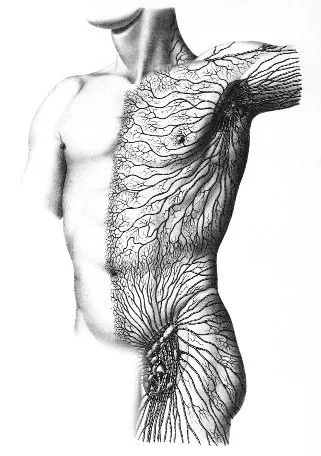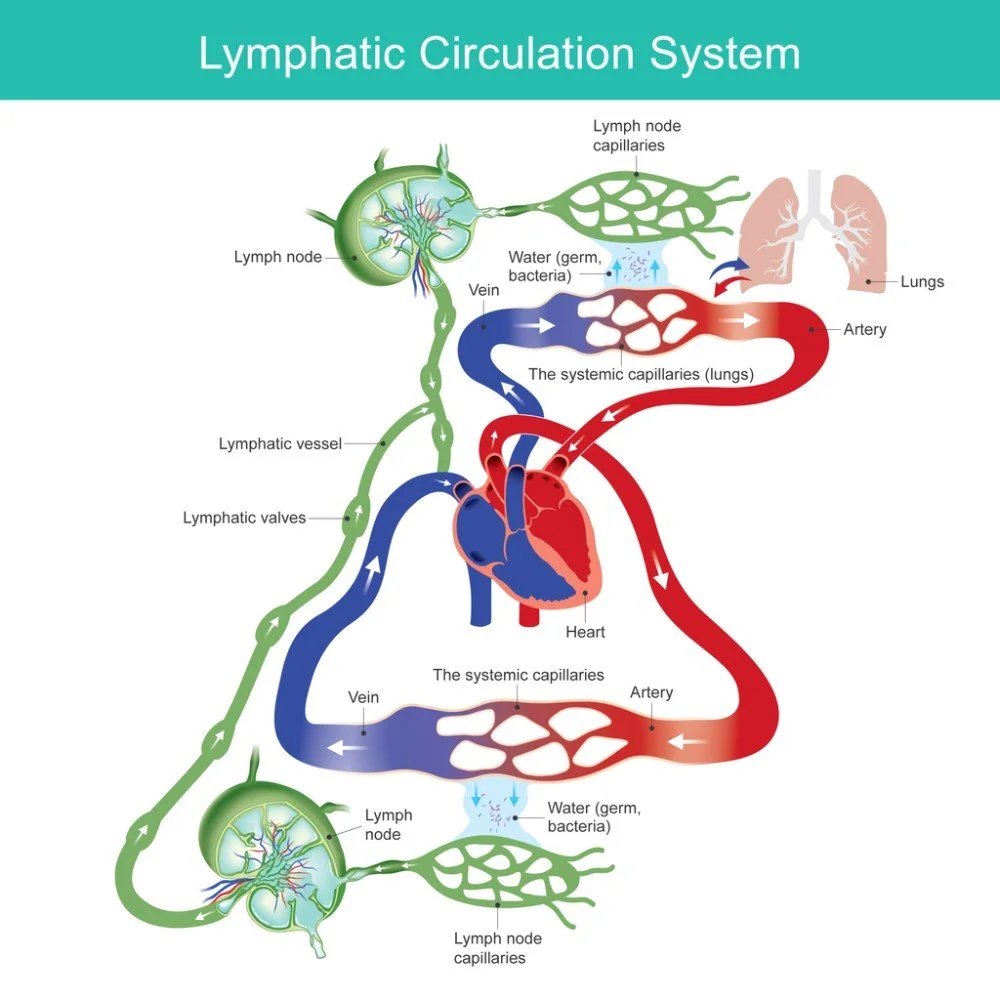5 Ways to Decrease Leg Swelling: Top Tips from a Certified Lymphedema Therapist
Authors: Meeghan Mackenzie, RMT CLT & Krizia Carlos RN, BN
10-15 minute read
The Transformative Power of Manual Lymphatic Drainage on Improving Lymphedema.
The lymphatic system is a complex and beautiful network of ‘water channels’, the water bearer of our wellbeing. At Renu, a Calgary-based clinic specializing in massage and manual lymphatic drainage. we’re passionate about helping people manage their lymphedema, restoring balance, and empowering bodies to heal from within. We’ve seen the incredible results of blending science and art within our community. Our hope is to inspire and empower you in your wellness journey with the right information and treatment.
To honour Lymphedema Awareness Month this March; today, we are going to talk about: The Lymphatic System, What is Lymphedema, and our Top 5 Tips for Managing Lymphedema.
Understanding the Lymphatic System
Anterior Aspect of the Body
Photo from: The Chikly Institute
Lymph from the French word lymphe meaning clear water; water which composes about 60% of our bodily system—water which is the vital force and lifeblood of our wellbeing and our planet. The word derives from the Latin term lympha meaning nymph or in a poetic sense, clear water. This was derived from the Greek term "νυμφη" (nymphe), a god-like spirit of a natural spring.
The lymphatic system is a complex and beautiful network of vessels, nodes, and organs that are working tirelessly behind the scenes to keep our bodies in balance. It's like a bustling city with its own highways (lymphatic vessels), checkpoints (lymph nodes), and waste management system (lymph fluid). It is often dubbed as the unsung hero of the body and is a remarkable network that quietly performs vital tasks to maintain our health and well-being
Functions of the Lymphatic System
1. Fluid Balance: The lymphatic system helps maintain fluid balance in the body by collecting excess fluid, known as lymph, from the tissues and returning it to the bloodstream.
2.Immune Response: Lymph nodes are essential for immune function, as they contain immune cells that help identify and destroy pathogens, such as bacteria and viruses.
3.Absorption of Fats: Specialized lymphatic vessels called lacteals absorb dietary fats and fat-soluble vitamins from the digestive system and transport them to the bloodstream for metabolism or storage.
Now, imagine what happens when this system encounters roadblocks, like surgery, injury, or genetic predispositions. This is where lymphedema occurs, which causes swelling, discomfort, and sometimes even pain.
What is Lymphedema?
Edema, from the Greek word oidēma, from oidein, meaning ‘to swell’. Lymphedema is water swelling; it is a condition characterized as a chronic and progressive swelling that occurs when the lymphatic system, which is responsible for removing excess fluid from the body, is damaged or disrupted. The mechanical insufficiency of the lymphatic system can lead to fluid buildup, causing swelling in various body parts, such as the arms, legs, or even the face. Multiple factors, including surgery, radiation therapy, injury, infection, or genetics, can cause lymphedema. - ACOLS
Stages of Lymphedema:
Stage 0: have no visible swelling (edema) or pitting, which refers to a temporary indentation in the skin when you press it. You may notice a mild tingling or slight heaviness or tightness in the affected area. You can have stage 0 lymphedema for months or years before obvious symptoms develop
Stage 1: Abnormal flow in the lymphatic system. No signs or symptoms. (Stage 0/1 are considered to be reversible stages)
Stage 2: Accumulation of fluid with swelling. ...
Stage 3: Permanent swelling that does not resolve with elevation. ...
Stage 4: Elephantiasis (large deformed limb), skin thickening with “wart-like” growth and extensive scarring.
Photos from: Minnesota Vein Centre
What is Manual Lymphatic Drainage?
So, what exactly is manual lymphatic drainage (MLD)? Think of it as a gentle massage specifically designed to stimulate the flow of lymph fluid and encourage drainage. It's like giving our lymphatic system a much-needed boost, helping it clear out excess and stagnant fluid to reduce swelling, therefore, alleviating the pressure that builds up in our tissues, providing pain relief. However, MLD isn't just about reducing swelling (though it does that exceptionally well). It's about restoring balance, empowering our bodies to heal from within.
What to Expect with Manual Lymphatic Drainage
Understanding what to expect with manual lymphatic drainage (MLD) is crucial for individuals seeking relief from lymphedema. Early intervention is key. Lymphedema is more common that you might think. At Renu, we witness the prevalence of this condition firsthand, we see anywhere from 1-5 new clients per week that are suffering with some form of Lymphedema. Some primary (hereditary) and some secondary (post-op/cancer patients).
During MLD sessions, our certified lymphedema therapists apply gentle, rhythmic movements along specific lymphatic pathways. By carefully manipulating the skin and underlying tissues, MLD helps to redirect lymph flow towards healthy lymph nodes, facilitating efficient drainage and reducing swelling. This hands-on therapy not only alleviates discomfort but also encourages the body's natural healing processes.
Our approach at Renu involves tailoring treatment plans to each individual's unique needs and physiology. We recognize that progress and response to treatment can vary significantly among clients. Therefore, we prioritize regular sessions to achieve and maintain desirable levels of improvement. We typically keep client in practice until we reach a desirable level of maintenance.
For some clients, this is quicker than others and is simply just based on their own individual physiology. We typically like to see clients as often as we can, about 1-2 times per week in the first 2/3 weeks; however, we are sensitive to the fact that treatment is not always affordable to the public as we are a private clinic, and unfortunately there is no relationship that the local medical governance - AHS - has with us. Click here for a more comprehensive article about lymphedema funding inequities in Canada.
Despite these challenges, we remain dedicated to providing quality care and support to our clients, striving to alleviate their symptoms and enhance their overall well-being. Through our commitment to individualized treatment and ongoing support, we aim to empower our clients in their journey towards managing and overcoming lymphedema.
How We Treat Lymphedema at Renu Calgary
Understanding the intricacies of lymphedema is crucial for Certified Lymphedema Therapists (CLTs), as even the removal of a single lymph node from the body can lead to its onset. Individuals who have undergone lymph node removal, regardless of the reason, fall into one of four stages of lymphedema.
One of our current clients exemplifies the challenges faced by those dealing with lymphedema. . Following a diagnosis of tongue cancer, he underwent the removal of 25 lymph nodes from his anterior neck and face, alongside partial tongue removal and subsequent reconstruction. Consequently, he now contends with lymphedema in his neck and face, which significantly impairs his ability to swallow and sleep comfortably. Moreover, he experiences the discomfort of untreated lymphedema, characterized by pain and pressure..
Fortunately, our team of highly trained CLTs at Renu were able to collaborate with him to create a comprehensive treatment plan. Utilizing advanced techniques; we were able to map his lymph and redirect it to healthy nodes so that we can start to clear the lymphedema from his neck and face. In addition; here are Renu Calgary, we also aid clients in fitting them with proper compressions; so, we had him fitted for compression to support the head and neck lymphedema treatments. Through our specialized care and expertise, we aim to alleviate his symptoms, improve his quality of life, and empower him in his journey towards recovery from lymphedema.
Treating lymphedema at Renu is not a one-sized fits all. It requires diligent assessments and a collaborative working relationship with the individual we are treating. Each individual has unique needs, and we have to be mindful to tailor each treatment based on individual needs and goals. You are the captain of your ship and we are here to assist you as co-captains so that you can have a smooth journey ahead in your healing journey.
5 THINGS YOU CAN DO TO MITIGATE OR TREAT LYMPHEDEMA:
1. Compression Therapy:
Wearing compression garments or using compression bandages can help reduce swelling by providing external pressure to the affected area. These garments should be fitted properly and worn consistently to achieve the best results.
Why Compression?
It has been our experience over the years that compression therapy is often not a conversation that is typically had with patients after their surgery. With that being said compression is a vital component in the management of lymphedema. Compression should be gentle, helping maintain lymph fluid balance, alleviate discomfort, and prevent developing lymphedema complications. Garments are designed to apply external compression to the affected area, which helps to stimulate lymphatic flow and reduce swelling. There are many types of lymphedema garments available, each designed for specific areas of the body and also the severity of the condition. At Renu Health we order compression from Juzo Canada and love the compression bras from Prairie Wear
Benefits of Compression
Reduced Edema: Compression therapy effectively reduces edema, alleviating swelling commonly associated with lymphedema.
Enhanced Lymphatic Flow: These garments promote better lymphatic circulation, helping to manage lymphedema symptoms.
Improved Comfort: Compression therapy can provide relief from discomfort and heaviness with the gentle, supportive pressure of compression therapy.
Prevention of Complications: By preventing fluid buildup and supporting tissue health, compression therapy helps prevent complications such as infections.
Supportive Management: Incorporating compression therapy into your lymphedema management plan provides consistent support and aids in maintaining limb size and shape.
2. Exercise:
Engaging in regular physical activity, especially exercises that promote lymphatic flow such as walking, swimming, yoga, or qi gong can help manage lymphedema symptoms. It's important to start slowly and gradually increase intensity under the guidance of a healthcare professional. Starting your movement journey doesn't have to be complicated. Regular walks, yoga, qi-gong, strength training or swimming are all positive. The most important thing is that it should feel good and should not progress your Lymphedema symptoms.
Krizia Canvas Training with White Tiger Qi Gong Instructor Elly Phoenix. 8 Trigram- Serving Teacups. Chinese Medicine: Benefits the 5 major Yin organs - Liver, Spleen, Lungs, Heart, Kidney
The Benefits of Exercise:
Improved Lymphatic Flow: Exercise stimulates lymphatic circulation, reducing swelling in lymphedema.
Enhanced Muscle Pump: Movement encourages muscle contractions which in turn help pump lymph fluid towards healthy nodes, aiding in its drainage.
Reduced Risk of Complications: Regular exercise lowers the risk of infections and other complications associated with lymphedema.
Better Mobility: Lymphedema and Radiation therapy can cause stiffness and tightness in the joint and muscle. Incorporating stretching in particular improves muscle and joint mobility and overall function of the affected limb.
Positive Mood: Physical activity boosts mood and mental well-being which is crucial for managing lymphedema.
Things to be mindful of with exercise:
Increase intensity gradually. It can be tempting to start exercising a lot right away, especially if prior to your onset of Lymphedema you were highly active, but high-impact activities can make lymphedema swelling worse or cause injury. For best results, start with low-impact exercises and gradually increase intensity and duration.
Pay attention to changes in swelling, discomfort, or fatigue during and after exercise. If symptoms worsen or persist, stop exercising and consult with your CLT, Oncologist, or Physio-Therapist.
3. Manual Lymphatic Drainage (MLD):
Manual Lymphatic Drainage is a specialized massage technique performed by trained therapists to stimulate the lymphatic system and encourage fluid drainage. It can help reduce swelling and improve circulation in the affected area. To do MLD on yourself, it is important to apply light pressure (approximately 5g or like rolling an uncooked egg across the table) in a brushing/skin stretching motion.
Lymphedema Treatments in Calgary
In practice at Renu Health when clients come and see us, we teach them exactly how to perform self-drainage on themselves and also show them the correct direction that their lymph travels in for their individual and specific presentation. Keeping up with self-drainage maintains reduction between sessions with your Lymph Therapist
Throughout the treatment process, we prioritize regular monitoring and assessment to track progress and adjust the treatment plan as needed. Our goal is to empower clients with the knowledge and tools they need to effectively manage their lymphedema and improve their quality of life. With compassionate care and comprehensive support, we strive to make a positive difference in the lives of those living with lymphedema.
Manual Lymphatic Drainage and Self-Drainage encourage:
Better Fluid Flow: MLD and self-drainage at home encourage stagnant lymphatic fluid to move towards healthy lymph nodes, keeping fluid buildup and swelling at bay.
Stronger Immune System Function: MLD's manipulation of lymph vessels and nodes may help improve your body's ability to fight infections and stay healthy by circulating immune cells in the system.
Scar Tissue Management: If you had surgery or radiation therapy (for example, for breast cancer treatment), MLD can help soften and mobilize scar tissue so that it heals better. It can also help with the prevention of fibrosis and axillary web syndrome also known as cording.
4. Skin Care:
Proper skincare is essential for managing lymphedema and preventing complications such as infections. Keep the skin clean and moisturized, avoid cuts and injuries, and use gentle techniques when handling the affected limb.
Communion Botanicals: Chamomile + Yarrow Soothing Skin Balm
Yarrow: A beautiful astringent, anti-inflammatory, and antimicrobial herb for keeping the skin clear. Traditionally used in herbal first aid as a beneficial topical wound-healer.
Regular Inspection: Check the skin daily for signs of redness, swelling, or infection, and report any changes to your healthcare provider immediately.
Gentle Cleansing: Use mild, fragrance-free soap and warm water to cleanse the skin, avoiding harsh chemicals and scrubbing.
Moisturize Regularly: Keep the skin well-hydrated with a gentle, non-irritating moisturizer to prevent dryness and cracking.
Protect from Injury: Avoid cuts, scratches, and insect bites to prevent infections. Use gloves when gardening or handling sharp objects.
Sun Protection: Shield the skin from the sun's harmful rays with sunscreen and protective clothing to prevent sunburn and damage.
Prompt Wound Care: Treat any cuts or wounds promptly with antiseptic and sterile dressings to prevent infection and aid healing.
Avoid Extreme Temperatures: Stay away from extreme heat or cold, as they can exacerbate swelling and discomfort in lymphedema-affected limbs.
5. Elevation:
If you have leg or arm lymphedema, elevating them can help improve drainage and reduce swelling. When you elevate your limbs, gravity helps to move the excess fluid toward the healthy nodes, encouraging better circulation and alleviating discomfort.
Making this a part of your daily routine helps lower the risk factors of complications such as cellulitis and bacterial infection of the skin because it minimizes stagnant fluid buildup in lymphedema-affected areas.
Incorporating limb elevation into daily routines is a straightforward and effective way for clients to take control of their lymphedema management. If you have leg or arm lymphedema, elevating them can help improve drainage and reduce swelling. When you elevate your limbs, gravity helps to move the excess fluid toward the healthy nodes, encouraging better circulation and alleviating discomfort. What makes it even better is opening your lymph node groups to encourage the vacuum effect in the body.
CLICK HERE to Follow along here for steps showing you how to open your system.
Reduced Swelling: Elevating the affected limb helps to reduce swelling by aiding in the drainage of excess fluid from the tissues.
Improved Circulation: Elevating the limb promotes better circulation, allowing blood and lymph fluid to flow more freely.
Prevention of Complications: By minimizing swelling, elevation helps to prevent complications such as infections and skin breakdown.
Enhanced Comfort: Elevating the limb can alleviate discomfort and heaviness associated with lymphedema.
Long-Term Benefits: Consistent elevation over time can contribute to maintaining limb size and shape and improving overall lymphatic function.
Making this a part of your daily routine helps lower the risk factors of complications such as cellulitis and bacterial infection of the skin because it minimizes stagnant fluid buildup in lymphedema-affected areas.
Supplement with Self-Care Techniques
While MLD is incredibly effective, there are also things you can do at home to support your lymphatic system. From gentle exercises to skin brushing and incorporating self-care techniques into your routine can enhance the benefits of MLD. Consistency is key when it comes to MLD. Schedule regular sessions with your therapist to keep the lymphatic flow going strong. Think of it as an investment in your health and well-being.
Final Thoughts
In summary, the lymphatic system is a beautiful body system we have to help maintain our health and wellness. It is well worth our time to understand, educate, and empower ourselves on how it works and how we can support and optimize its functions. Lymphedema is a common chronic condition where personalized management is key to maintaining well-being. Every individual's path is distinct, highlighting the importance of tailored care and self-management. While living with lymphedema may pose challenges, it's essential to recognize that pain and discomfort aren't unavoidable. With appropriate treatment and support, individuals can lead fulfilling lives, embracing their journey with compassion and determination. Here's to a journey of healing, one gentle stroke at a time.
"Through the cracks of our brokenness, may the light of healing shine, illuminating the path to wholeness and redemption." - Elizabeth Gilbert
Affiliate Link Disclosure:
Some of the links on this website are affiliate links, which means that I may earn a commission if you click on the link or make a purchase using the link. When you make a purchase, the price you pay will be the same whether you use the affiliate link or go directly to the vendor's website using a non-affiliate link.
We only recommend products or services that we genuinely believe will add value to i readers. Your support in purchasing through these links enables us to keep this website running and to continue providing valuable content to you. With love and gratitude,
-Renu Health YYC






